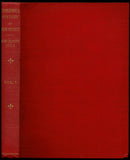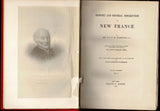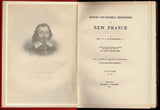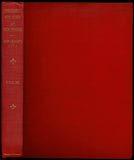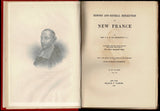History and General Description of New France
Author: Pierre François Xavier de Charlevoix (1682-1761)
Year: 1900
Publisher: Francis P Harper
Place: New York
Description:
6 volumes. xiv-[15]-286+[directions to binders] pages with frontispiece, folding maps, plates, bibliography and tables. iv-[5]-284+6+[directions to binders] pages with frontispiece, facsimiles, plates and folding maps. vi-[7]-312+[directions to binders] pages with frontispiece and folding maps. viii-[9]-308+[directions to binders] pages with frontispiece, folding map, facsimiles and plate. xi-[12]-311 pages with frontispiece, maps and facsimiles. x-[11]-256+[directions to binders] pages with frontispiece, plate, maps and charts and index. Small quarto (10 3/4" x 7 3/4") bound in original publisher's red cloth with gilt lettering to spine. Translated and edited by John Gilmary Shea with a new memoir and bibliography of Noah Farnham Morrison. (Howes C-307) Limited to 750 copies of which this is number 81. Originally published in French in 1744 in three quarto volumes.
Pierre François Xavier de Charlevoix, S.J. was a French Jesuit priest, traveler, and historian, often considered the first historian of New France. He had little interest for "a life of suffering and deprivation for the conversion of Indian souls", but "an eager curiosity concerning life".
Between 1705 and 1709, Charlevoix was sent for his period of training in the Society called the regency to the Jesuit College in Quebec in the French colony of Canada, where he taught grammar. Upon completion of this stage of his training, Charlevoix returned to the College Louis-le-Grand in Paris to study theology, becoming a professor of belles lettres. Charlevoix was ordained as a priest in 1713. In 1715, he published his first complete work, on the establishment and progress of the Catholic Church in Japan.
Charlevoix's work was halted by a royal commission that requested a survey of the historic boundaries of Acadia, a French North American colony recently lost to the British in the 1713 Treaty of Utrecht. He sailed from La Rochelle in June 1720 and reached Quebec by the end of September. His knowledge of North America led to an extension of his assignment, under instructions to find a route to the "Western Sea" but "still give the impression of being no more than a traveler or missionary." Having recently lost control of the Hudson Bay and lacking funds for a major expedition, the French Crown equipped Charlevoix with two canoes, eight experienced companions, and basic trading merchandise. From Quebec, he set out for the colony of Saint-Domingue via the Saint Lawrence River and the Great Lakes to Michilimackinac, where he made an excursion to the southern edge of Green Bay. He traveled along the eastern shore of Lake Michigan, trying to reach the Illinois River from the Chicago, but the shallowness of the water forced him up the St. Joseph to the headwaters of the Theakiki, whose waters fall into the Illinois River. He traveled along the Illinois until he reached the Mississippi River in 1721, which he considered "the finest confluence in the world". Visiting the Illinois Country along the way, Charlevoix traveled down the Mississippi to its mouth at the Gulf Coast. He embarked on a ship at New Orleans for the sail to the island of Saint-Domingue in the Caribbean, but it was wrecked at the entrance of the Bahama Channel. He was aided by nuns of the order of the Ursulines of Quebec, whose founder St Marie of the Incarnation later was the subject of one of his books. Charlevoix and his companions returned to the Mississippi River via following the coast of Florida.
Charlevoix's second trip to Saint-Domingue was more fortunate. He arrived in the colony at the beginning of September 1722. He departed for France at the end of that month, landing at Le Havre on 24 December. Charlevoix kept a record of his entire expedition, which he published as the Journal d'un voyage fait par l'ordre du Roi dans l'Amérique Septentrionale de la Nouvelle France Charlevoix's records of local geography were later used to improve regional maps. Unsuccessful in reaching the Pacific, he reported upon his return to France in 1722 of two possible routes: by the Missouri River, "whose source is certainly not far from the sea", or by the establishment of a mission in Sioux territory, from which contact with tribes further west may have been possible. In 1744 he published his History of New France, drawing on various authors as well as his own observations, thus providing the most comprehensive book on the history and geography of the French colony. (Wikipedia)
Condition:
Corners bumped, some soiling to covers else very good.






